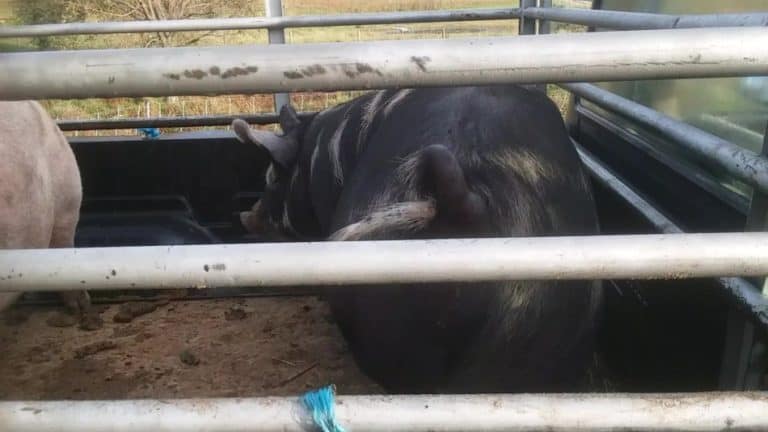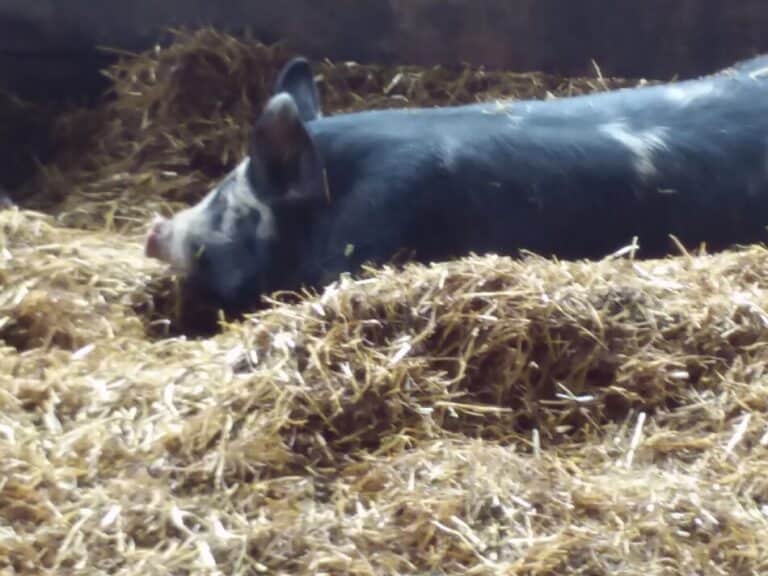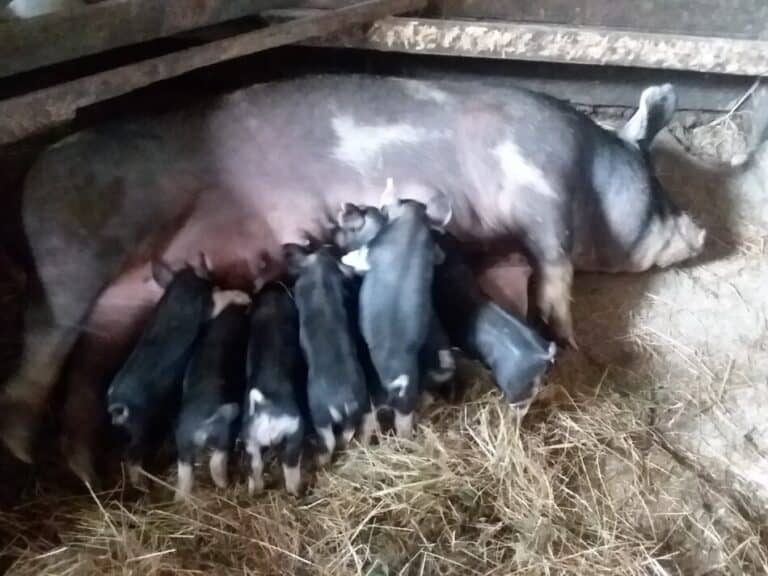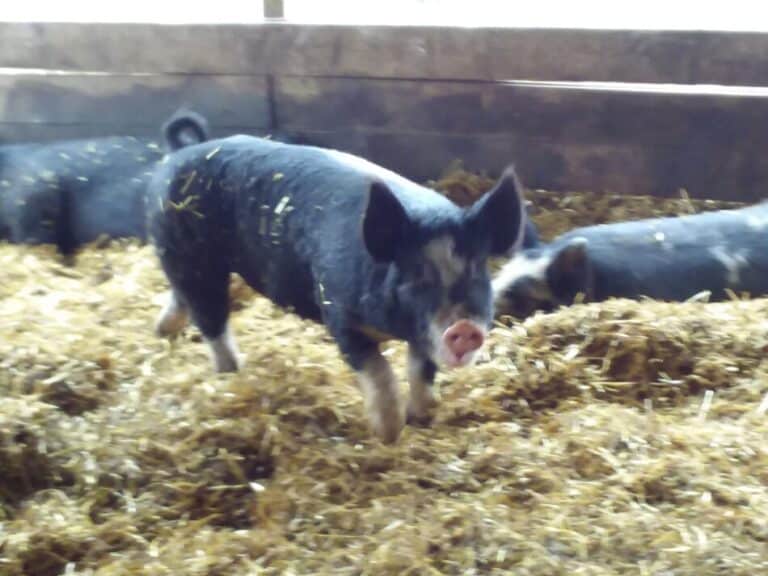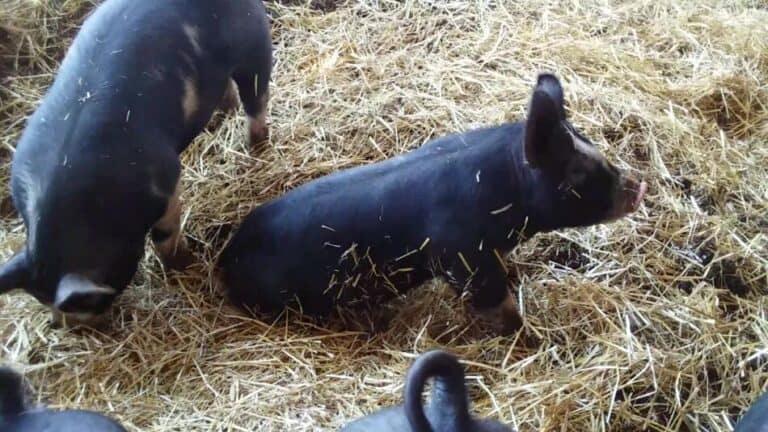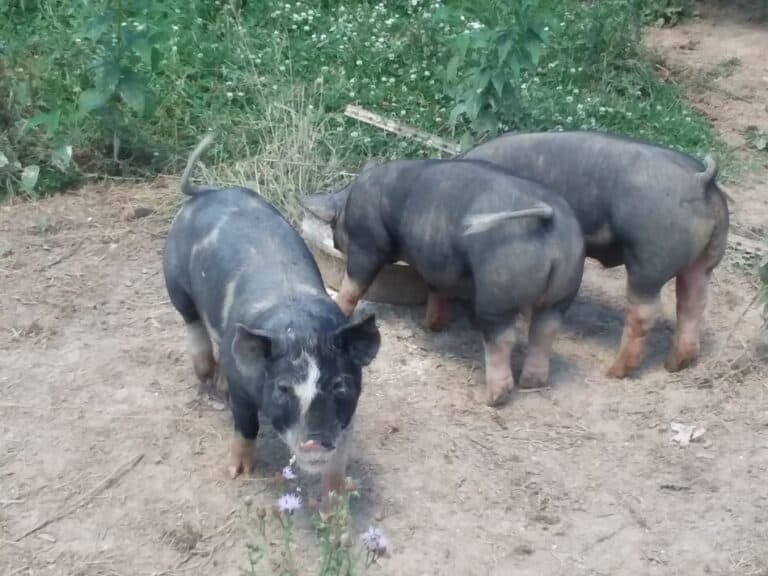How To Take Care Of Pastured Pigs

Pigs on pasture, what a great way to raise your own pork! How do you keep your pigs (and yourself) happy while you are raising pigs on pasture?
The best way to care for pastured pigs is to start with healthy feeder pigs, raise them in groups of 2 or more with plenty of water, some shade and free choice ground feed in addition to the pasture, so the pigs can choose the daily balance of feeds eaten.
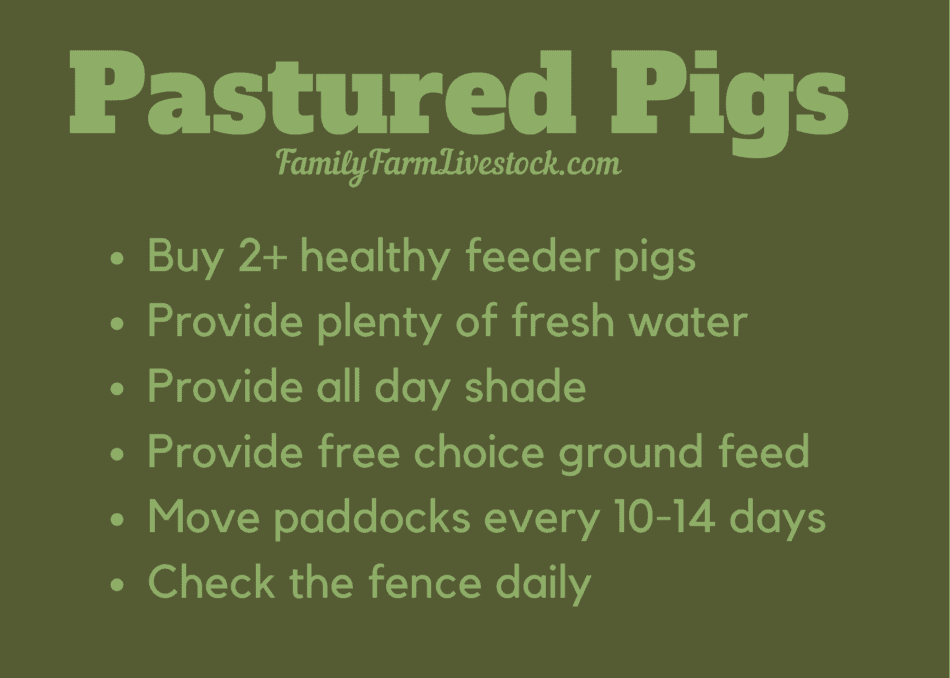
Great pastured pigs start out healthy
The feeder pigs you get to raise need to be healthy from the start. Never, never, never buy anything other than a healthy, well grown feeder pig!
Starting out with a “deal”, which will wind up more costly when you tally up the time and costs, will end up with you having extra stress and headaches rather than high quality, fast growing piglets.
Get high quality, shiny and spunky feeder pigs to start with, you’ll be glad you did!
What to Look for When Buying Feeder Pigs? is an article I wrote that will help you out.
Pigs on pasture need to be raised in groups of 2+
Pigs are social and need to be raised in a group. Granted, a group of two is a small group but as long as your pigs have at least one buddy, they will be happy.
I know it can be a bit much to figure out what you are going to do with the meat from two or three pigs!
Unless you have a really big and really empty chest freezer, you’ll need to figure out someone else who wants some home raised pork!
The great news is that while tons of folks love to eat pork, not everyone is willing or able to raise their own pigs for meat, so you can help.
Offer up your extra pigs to your friends and relatives and see if there are any takers. I think you’ll be surprised!
Pigs On 5 Acres gives you a start on planning your pig pasture rotation in a way that works for you and your farm.
Pastured pigs need plentiful water
Pigs need plenty of water to grow their best. Limit their water and you limit their growth, it’s that simple.
The catch is that pigs are also smart enough to figure out how to waste water by spilling or using their noses to press on the water nipple and make a mud hole out of the drips. This wastes a good bit of water!
Make sure your pigs can get all of the water they want for the day, even if they end up spilling some.
This is especially important to remember in the heat, when your pigs will use the mud hole they make to have a wallow so they can cool off.
I try to make sure my pigs can make a wallow, or I’ll even help them by getting one started in the heat.
I don’t care for the mess, but it makes them so much more comfortable when it’s hot to be able to get down in the mud and cool off.
For their sake, I’m pro wallow in the heat. But all of this takes more water. Make sure they have all the water they need to drink and then some.
Figuring out how to play in the water will happen, you might as well be ready!
Pastured pigs need to eat more than grass
Feed your pigs a ground feed, free choice, that is specific to their weight. You don’t need to be too exact here, but do your best.
Your pigs will gain their best on full feed, which means all they can eat feed and water 24 hours a day. If they want a snack, they go get it, it’s that easy.
If you are feeding the pigs out of pans, expect them to grow a bit more slowly, since you are in effect limiting their feed by feeding a certain times of the day.
If you are getting good results, super. If you think your pigs should be growing faster than they are, make sure the piglets have full feed
Most pigs need to eat more than grass. Why? Pigs are omnivores, like you and me.
Pigs can eat greens, of course, but they need sources of higher calories, like fats and carbohydrates for their digestives system to be able to work well.
Pigs on pasture will get a noticeable amount of their daily feed intake from the pasture, somewhere in the neighborhood of 30% (link to Grassworks.org, Small Scale Hog Production), meaning 70% of their daily calories still will come from grain.
If you want to try to reduce or eliminate grain, read Sugar Mountain Farm blog by Walter Jefferies. He and his family raise pigs grain free in Vermont. Here’s a link to the overview of Pigs, going over the basics of their operation.
When you read through, be sure to note which other calories sources he provide tries to his pigs so they can grow well while on pasture and the fact that these pigs have been selected over the past 20 years to perform in this system.
Pigs on pasture need shade
Your pigs need some sort of shade. If you are fortunate enough to have a few good sized trees in our pasture, or maybe even have included the edge of a woods in your pig pasture, you are set.
Trees or substantial shrubs will be “shady” enough for your porkers.
If you are in a more open area, then you’ll need to bring in some shade. Good news, you have some options.
You can park a trailer or wagon in the pen for shade. You can put up a tarp or a roof. Use your imagination, pigs aren’t picky as long as they can lay in the shade to nap.
Be sure your shade stays in the pasture the entire day. By that I mean, as the sun moves, does the shade stay in the pig’s pen, or is the shelter shading some spot outside of the pen that the pigs can’t get to?
More than likely, you’ll want the shade to be in the middle of the pen, that way when the sun moves the shade stays in the pen where it’s usable for your feeder pigs.
Good fencing is a must for pastured pigs
Good fences are a huge part of pastured pigs for two reasons: pig containment and keeping the pigs off of the fence.
The fence itself does not have to be much, especially if it is an electric fence. You can put up strands of wire or polybraid or use an electric netting if you are choosing to contain your pigs with electric.
Of course, the piglets need to be trained to the fence first! To train piglet to the wire, put the 50+ pound feeder pigs in a hog panel pen and run a hot wire across inside the pen so they can learn what it is.
Once all of the pigs have tested the wire, they’ll do this on their own, you should be good to go.
If you start with smaller feeder pigs, keep them in the panel pen until they are bigger. Smaller feeder pigs are going to be hard to contain, since they are so short and light weight they are harder to shock.
If you have a more permanent fence set up like woven wire or are not using electric at all, the bigger deal with the fence is to keep the pigs contained, yet not let them ruin the fence itself.
As cute as your pigs are now, they will ruin your fence by digging under it as they get bigger.
You can prevent pig escapes by keeping them from touching the fence with a strand of electric run around the bottom of your fence.
If you are using cattle or hog panels as your main fencing, keep monitoring the “work” your pigs are doing. Get out in that pen and see what those characters have been up to.
If they are working on digging out, move the pen or put in a few more T posts to hold the panels in place.
I had three piglets in a hog panel fence last summer. It worked great, until they got a little size to them and started trying to dig their way out.
These three were pretty mild mannered, I really should have had containment problems with them far sooner than I did. I guess they were just a bit lazy!

You’ll want to rotate the pig’s pasture areas
To keep your pasture looking good and keep the pigs busy, you’ll want to rotate the area the pigs have access to.
How often you rotate depends upon how big the area is to start with and how much “work” the pigs have done there, so far.
If you leave them in one spot until it is a “moonscape” you’ll have a muddy mess that will take seemingly forever to regrow.
The easy answer here is to move the pigs while there is still some grass left in their paddock!
Most folks are rotating their pigs anywhere from every 10-14 days, with longer rest periods of 21 or more days. Usually this number is based around the pigs eating the feed in the feeder so it can be moved to a new area.
Other people pasture pigs with a central pig area that has good access for the feed, water and shelter, then run electric fence lines off of the central area for the grazing areas.
The design will look like a wheel with the main area as the hub.
If you are trying to get the pigs to renovate an area, you may want to keep them in one spot for an extended period. Once again, how long depends on what exactly you are doing and why.
All pigs will root, it’s only a matter of how much
No matter what the breed brochure says, all pigs will root. Some will root more than others, sometimes a lot more! But all pigs will root, especially in wetter soil.
I know some breeds are being promoted as pigs that don’t root, I’m skeptical. If you had a friend who got pigs that seem to root less than most, sure, I can see that. But no rooting at all? That’s tough to believe.
It could be that I am misunderstanding the “no rooting” and what they really mean is less rooting. That could easily be the case. There are pigs that seem to root less than others, but, once again, they still root.
Wet ground equals pugging from pig’s feet
Another part of pasturing pigs that seems to get left out is the part about the pigs sinking into the dirt when the ground is wet. This is simply because pigs are heavy for the size of their feet.
Even if you rotate your pigs, you’ll get pugging in the high traffic areas, especially if those spots are wet, like around the waterer.
If you keep pigs in one area, they’ll eat all of the grass and you’ll eventually get a dirt lot instead of a pasture in that spot.
In each new pen, you’ll still get an overworked area, but moving them on the 10-14 day schedule will keep that overworked spot to a minimum.
If you can’t move the pen, put in lots of bedding for your pigs
If you can’t or do not plan to rotate the pen, put in bedding to give them a nice bedded pack to play in. You’ll need to use a quite a bit of bedding, since you want the straw to stack up to keep the pigs out of the mud.
Sadly, there are times of the year when the weather will not cooperate with your plans! Or you are getting a crazy wet year and what would have normally worked, isn’t happening this year.
Adapt and make adjustments to keep your pigs happy.
A big pile of bedding will give them a nice, dry spot to make a nest. They’ll want to mess around rooting in the mud, but they’ll also want a dry place to rest and sleep!
Resources:
Grassworks.org Small Scale Hog Production, this is where I got the figure 30% of the finishing ration (feed for pigs to be butchered) can be pasture. This is a great resource, be sure to read through it.
